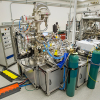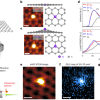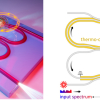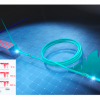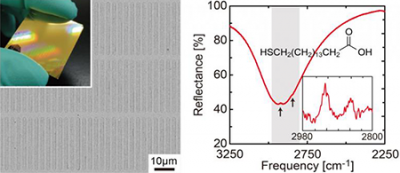
Plasmonic metamaterials are man-made substances whose structure can be manipulated to influence the way they interact with light. As such, metamaterials offer an attractive platform for sensing applications, including infrared (IR) absorption spectroscopy. Now, Atsushi Ishikawa at Okayama University and his collaborator, Takuo Tanaka at RIKEN’s Metamaterials Laboratory, Japan, have fabricated a novel plasmonic metamaterial absorber comprised of gold and magnesium fluorine capable of high sensitivity IR detection. The metamaterial could prove invaluable in the development of next-generation IR inspection technologies. They reported their work in Nature Scientific Reports.
The researchers carefully designed their absorber to maximise the IR signal and minimise background noise. The metamaterial consists of 50-nm gold ribbons on a thick gold film, separated by a layer of magnesium fluorine (see image). Infrared radiation is not strong enough to excite electrons, unlike other types of spectroscopy. IR absorption spectroscopy therefore exploits the ability of IR to induce vibrations in bonded atoms. Organic compounds will absorb IR radiation corresponding to the different types of molecular vibrations present; the resulting absorption spectra tell scientists about the unique chemical structure of the compounds.
To test the capabilities of the new metamaterial, the team decided to identify the stretching vibrational modes of carbon-hydrogen bonds in 16-Mercaptohexadecanoic (16-MHDA) acid. They dipped the absorber in 16-MHDA ethanol solution to encourage a self-assembling monolayer of the acid molecules to develop. Under IR radiation at different incident angles, the metamaterial–monolayer spectral output displayed distinct peaks corresponding to carbon–hydrogen stretching, with the most pronounced peaks under IR at an angle of 40°.
The new metamaterial approach gave highly-detailed measurements pertaining to tiny molecular details (at the attamole level) in the 16-MHDA monolayer. The researchers hope their new technique will open doors to the development of ultrasensitive IR inspection technologies for material science and security applications.
Metamaterials
The ability to manipulate the light absorption of materials could revolutionise many technologies, such as photovoltaic cells and thermal devices. Research into the design and development of plasmonic metamaterials is still relatively new. These materials are synthetic, and scientists can design their surface structures to exploit the behaviour of surface plasmons—quasiparticles that exist on metal surfaces and interact with light—to achieve tuneable optical properties.
Infrared absorption spectroscopy could be dramatically enhanced by the introduction of tuneable metamaterial-based absorbers designed to enable high-resolution detection of tiny molecular details.
Methodology
The metamaterial absorber built by the team comprised gold nano-ribbons (measuring 50 nm thick) on a gold film base, with a thin layer of magnesium fluorine separating the two gold layers. As molecular monolayers self-assemble on noble metal surfaces, they hypothesised that the gold-based metamaterial would prove a strong candidate for enabling the high-resolution measurement of IR-induced vibrational modes in self-assembling monolayers.
Their approach involved covering their metamaterial absorber with an ultrathin self-assembling monolayer of 16-MDHA acid molecules. They also covered a bare gold film sample with the same monolayer for comparison.
The researchers subjected the two monolayers to IR radiation at different incident angles. The monolayer on bare gold exhibited a low signal-to-noise ratio, and it was very difficult to see the absorption dips on the spectral output corresponding to the IR-induced carbon–hydrogen stretching in the monolayer.
In contrast, the absorption dips were very well-pronounced in the spectral read-out for the metamaterial-monolayer, because the vibrational modes of the 16-MHDA molecules resonated with the plasmonic modes of the metamaterial. This so-called “resonant coupling” produced distinct peaks corresponding to IR-induced carbon–hydrogen stretching in the 16-MHDA molecular structure. The resonant coupling was dependent on the angle of the incident light, with the clearest, strongest signal at an angle of 40°.
Future work
The researchers believe their absorber may open doors to new ultra-sensitive IR detection technologies. Further, their technique could be exploited in other ways: by optimising the surface structure of other metamaterials, they could enhance resonant coupling still further and enable sensitivities down to the zeptomole level.











